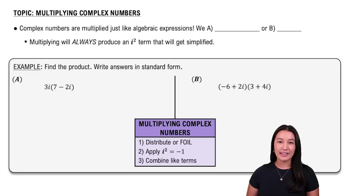Here are the essential concepts you must grasp in order to answer the question correctly.
Complex Numbers
Complex numbers are numbers that have a real part and an imaginary part, expressed in the form a + bi, where 'a' is the real part and 'b' is the coefficient of the imaginary unit 'i', which is defined as the square root of -1. Understanding complex numbers is essential for performing operations such as addition, subtraction, multiplication, and division.
Recommended video:
Multiplication of Complex Numbers
To multiply complex numbers, you apply the distributive property (also known as the FOIL method for binomials). For example, when multiplying (a + bi)(c + di), you multiply each part: ac, adi, bci, and bdi^2. Remember that i^2 equals -1, which is crucial for simplifying the result into standard form.
Recommended video:
Multiplying Complex Numbers
Standard Form of Complex Numbers
The standard form of a complex number is expressed as a + bi, where 'a' and 'b' are real numbers. When simplifying the product of two complex numbers, the goal is to combine like terms and express the result in this standard form, making it easier to interpret and use in further calculations.
Recommended video:
Complex Numbers In Polar Form
 Verified Solution
Verified Solution



 3:31m
3:31m
